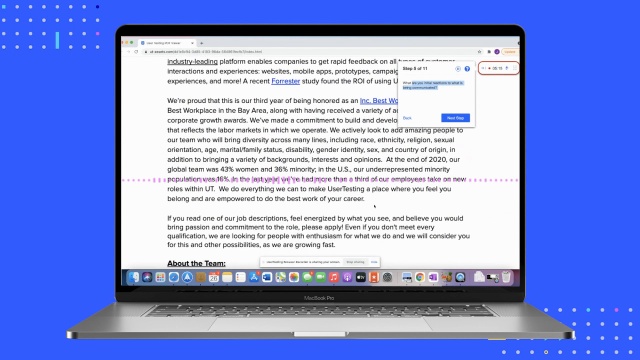
How to update your job postings to attract top talent

With a big influx of jobs open in the market, in part due to the Great Resignation, employers are having a tough time attracting potential candidates and filling much-needed roles. There are many factors that go into why someone would apply for a role, but having a clear and concise job posting—coupled with your other sourcing efforts—will put you miles ahead of the competition.
At UserTesting, the Talent Team uses the Human Insight Platform to collect candid feedback on job postings and communications to ensure that we’re attracting the best talent and providing a positive candidate experience.
Job postings play a crucial role when getting job seekers to apply for an open role. In order to get people excited about a job, we’ve distilled four main components that should go into an engaging job posting:
1. Clearly describe the role’s responsibilities
It may seem obvious, but it’s critical to clearly describe the responsibilities of a role and provide an accurate view of the skills you’re looking for. This goes beyond what you consider accurate and clear. It’s important to speak in such a way that’s clear to the applicant—job-related jargon may be necessary, but think about the way you describe internal processes that may not be universally recognized.
When a potential candidate is reading through the job posting they want to be sure that they understand what they’re signing up to do and if they qualify for the position. This is especially true for women and minorities job seekers who tend to not apply for a role unless they check all of the qualifications listed.
Here are some ways that we have adjusted our practices to ensure we are attracting job seekers that are a great fit:
- Have alternatives for “like skills” mentioned in your posting in order to open up a wider funnel for accepting talent. For example, if you say that a role requires a 4-year college degree, is there an equivalent amount of experience that someone can earn in the market without having to meet that specific need?
- For skills that would be “nice to have” but are not required for the role, be sure to note this so that you’re accurately portraying the starting point for the role.
- Add language that expresses if a candidate doesn’t meet all of the criteria but is interested in the role, that you’d still like them to apply. This supports job seekers that may have some transferable skills or are looking for a stretch role.
2. Share information about the team culture
Sharing information about the team culture helps candidates see themselves working on your team. This is where you can dive into the “day in the life” of someone who is joining your specific team.
While your career site should focus on your company’s culture, the job posting can help shed light on how your specific team operates, what locations your team is in, and even how you choose to communicate with one another. Giving the candidate insight into the team that they’re thinking about joining may be the extra push they need to go from consideration to submitting an application.
3. Use inclusive language
Using inclusive language on your job postings communicates that your company is aware of diversity, equity, and belonging. Ensuring that your job postings have language that is inviting to people from all backgrounds is important to attract a diverse pipeline that leads to top talent. Being cognizant that some words or phrases are a turn-off (or on) to certain groups of people will help you adjust your posting to be more inviting.
There are companies out there that are able to help you with ensuring that the language you’re using is inclusive or, if you have one, you can lean on your diversity and inclusion or communications departments for guidance.
Don’t forget, you can always test your copy with real people before you publish. Hear what one person had to say positively about our job postings.

4. Consider your job posting’s length
Be mindful of length when crafting a job posting. While fitting all seemingly relevant information into a clear and concise format may be difficult, your potential candidates will thank you. Reading lengthy job postings will deter job seekers from actually filling out an application.
For example, listen to someone provide feedback about the length of one of our postings.

Our advice: stick to the important sections that candidates tend to gravitate towards most (responsibilities, requirements, and reporting relationships) and lighten up anywhere else that you can.
In closing...
The UserTesting platform has allowed us to better empathize with job seekers, understand what they feel is important, and adapt our messaging to align with their feedback. We hope you take these insights and apply them to your own talent processes. After all, without feedback, it’s often difficult to know where you have opportunities to get better.


